Join Product Education Specialist Patrick Collier and Product Manager Spencer Kotter for an insider’s look at Marq Studio – a powerful new template management experience that transforms how admins work with their template libraries.
During this 30-minute training, you’ll see how Studio eliminates tedious one-by-one template updates through powerful bulk actions. Learn how to:
- Efficiently manage hundreds of templates at once
- Schedule template visibility for campaigns, and
- Utilize new organizational tools that put you in complete control of your library
Watch to discover features that will save you hours of admin work, including mass updating of template categories, names, and sharing settings – all designed to streamline your template management workflow.
Physics is to Albert Einstein as branding is to David Brier.
A walking, talking brand himself, David Brier graced our screens three weeks ago for a webinar that divulged the 19 questions every organization should ask before rebranding.
I have to admit, I expected all the cliché questions: Who is our audience? What is our core strength? Yadda, yadda, yadda. But David proved he isn’t a world-renowned rebrand expert for simply stating what I already learned in Marketing 101… he’s world-renowned for asking the kind of questions that require intense (organizational) introspection. Questions that actually make you think.
Intrigued? Watch the full webinar here and read to follow along.
David Brier’s draw can probably be attributed to his three decades of branding experience, but on a personal note, I think the bold, in-your-face personality may have a little something to do with it too. Case in point? “I’ve been compared to a triple-shot espresso.”
His words, not mine!
Now… sit back, relax, and let me take you on a journey through David’s mega-marketing mind as I summarize some of the insights we learned during his webinar. And remember, you can always just watch the recorded webinar in full if you’d rather hear it straight from him.
Why do companies rebrand?
Here’s a shocking fact:
For some reason, we as marketers can forget this minor detail. Entire populations who were once our brand loyalists don’t stay that way forever. They’re replaced by an entirely new generation of new human beings with new opinions and needs. Which means you need new messaging.
In David’s words: “With today’s technology, these changes are happening faster than ever. To stay relevant, sometimes the correct strategy is a rebrand.”
So we embrace the fact that the world constantly changes, we stay relevant, and we resonate with the new generations as they come. Easy, right?
Well, as David points out, companies repeatedly struggle to pull off an effective rebrand.
It’s that wall. No matter how hard you market and how targeted your campaigns are, there still seems to be a disconnect between you and potential customers.
The problem? Clichés.
David explained how certain phrases like “state of the art,” “knowledgable staff,” and “caring customer service” (who talks like that, anyway?) can alienate companies from their audience and be too predictable to hold interest.
More importantly, clichés distract from good branding.
Branding the right way
According to David, the definition of good branding is good differentiating. No surprise there, right? Stand out from the competition and potential customers will notice you more. As David reminds us: “Differentiating is not a luxury. You differentiate if you want to survive.”
You differentiate if you want to survive.
Now that’s a bold statement.
He’s got a point, though. The great thing about David is that he doesn’t make a bold statement without something to back it up. In this case, that something is a slew of real-world examples. Real brands that had real problems until he swooped in and differentiated the heck out of them. I’ll let you discover the intriguing before-and-after brand transformations when you watch webinar in full.
The 19 rebranding questions
The stage has been set. We understand why companies rebrand, what branding is, and why it matters. Now for the hard part—how to actually go through with a rebrand.
It’s about time we dive into the 19 questions, isn’t it?
I’ll cover the first five questions here. If you want the remaining 14, I’ll let you watch David reveal the rest himself.
Rebranding question #1: Why are we doing a rebrand?
Seems like an obvious question, but as David points out, many companies make the mistake of rebranding simply to rebrand—to be “prettier” and to change things up. But rebranding is not worth the time and money if it doesn’t revolve around strategy and relevancy.
Rebranding question #2: What problem are we attempting to solve?
Does your packaging get lost on the shelf? Is your product not valuable to customers once they get it? Figure out the problem you are trying to solve, and let rebranding help fix that problem. If you don’t have a clear objective to your rebrand, rebranding really won’t do you much good.
Rebranding question #3: Has there been a change in the competitive landscape that is impacting your growth potential?
As much as we’d like to think our brand isn’t impacted by the decisions of other brands, it is. No brand exists as an island. You always have to be watching the landscape around you, and be nimble and fluid in response.
Rebranding question #4: Has our customer profile changed?
Yesterday’s innovation becomes today’s normal, and new innovations can drastically change our customer profile. Don’t blindly base your strategy on information that could have been relevant for your audience five years ago but has no place in your brand today.
Rebranding question #5: Are we pigeonholed as something that we (and our customers) have outgrown?
Many times, businesses evolve as they grow. They start out with a certain focus, then shift that focus as time goes on. For example, a 25-year-old dance institution that still used a ballet dancer in their logo admitted to David that ballet now accounted for only 15% of their training. It’s a prime example of a brand pigeonholing themselves by not keeping up with their own evolution and growth in their branding.
As for the last 14 questions, they really are worth reviewing. David’s tips are chock-full of insights that get you to fight for your rebranding strategy—to really have a reason for how and why you’re doing it. A true rebrand should be hard—it should challenge your fundamental beliefs about your organization and spark new ideas of how to better hone in on the core value it provides.
Thinking about a rebrand? If it’s time for a brand intervention, you won’t want to miss our webinar with branding expert David Brier.
In the digital age, we are constantly surrounded by bleeping phones and notification alerts. The onslaught of incoming communications can seem incessant and unceasing. Most modern consumers are surrounded by distractions, and marketers have a tough job helping their brands catch the attention of prospects.
Related: Create strong emotional connections with your brand story
Often, an effective approach is to add to the stream of information and hope to outdo competitors by offering big discounts and exclusive deals. These quick wins can help your business reach its short-term goals, but they won’t lead to long-term loyalty from consumers. Brands need to build trust with customers so they come back time and again—a one-off discount can’t achieve this.
Instead, the best-known and longest-surviving brands create and nurture emotional connections with their customers—turning them into faithful followers. To do this, marketers use emotional branding. It can take some time to reach the point where your customers’ actions are fueled by emotion, but it is worth the investment, as repeat customers are extremely valuable.
Why invest in emotional branding?
It costs more to acquire a new customer than it does to keep one. The exact figures vary, with different studies suggesting it can be between 5-25x more costly to attract a new buyer than to retain one. One Harvard Business School study suggests that improving customer retention by 5% will increase a company’s profits by between 25% and 95%.
Every marketer knows that building a strong brand is hugely important in distinguishing a business from its competitors. But, they may not realize just how much it can impact their bottom line. A successful brand goes much deeper than its logo; it creates an emotional connection with customers.
Emotional branding defined
Emotional branding is about building a brand that appeals directly to consumers’ emotions, needs and ambitions. With emotional branding, marketers aim to trigger an emotional response in consumers.
By provoking emotions, marketers can create a bond which disrupts traditional consumer decision-making models. These models are largely based around the idea that consumers make a purchase based purely on logic, but these models are changing.
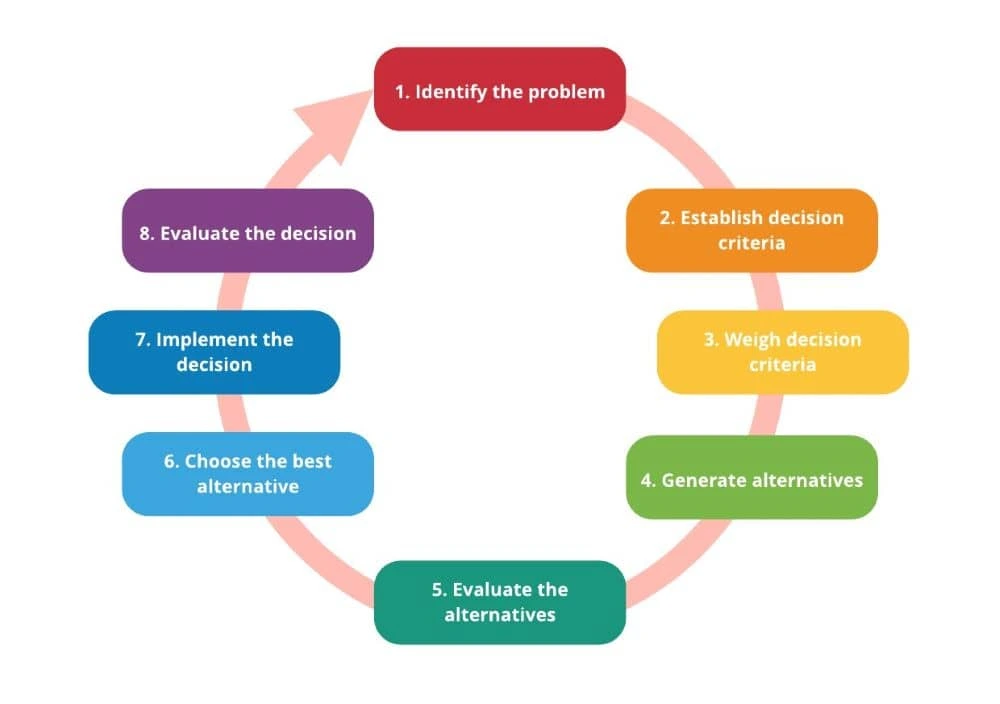
Quizlet’s rational decision-making model,lovingly recreated in Lucidpress
When emotional branding comes into play, decisions can become irrational. When given the choice between two similar products, a consumer may simply follow logic and choose the cheapest or most convenient option. However, when emotion is in the mix, they may choose to buy the brand they relate to most.
It’s easy to see how building an emotional bond with consumers can increase profits and why premium brands like Nespresso and Coca-Cola engage in building emotional connections with their customers.
Often, people choose purchases based on ego rather than necessity. Consumers can show who they are through the brands they choose—and they are willing to pay more and go out of their way to do this. It is up to marketers to position their brands in a way that will connect and resonate with their target audience. When done right, cutting through the distractions of the modern world will come easy.
How to incorporate emotional branding in your marketing strategy
The likes of McDonalds, KFC and Disney employ a number of methods to connect in a meaningful way with consumers. The longer a business is around, the easier this becomes, and many brands take advantage of anniversaries and nostalgia to bond with their market.
But, newly founded businesses don’t need to miss out. Here are just some of the approaches to emotional branding that can be used to bond with consumers.
1. Show your customers you care
To succeed at emotional branding, it’s essential to thoroughly know your audience. You need to treat your customers as people rather than faceless consumers. Do your research, conduct surveys, then decide how you can connect with your audience.
What do they value? What triggers them emotionally?
Once you’ve decided which emotion you want to tap into, this should consistently be evident in your marketing messages. From social media to customer care, a brand should constantly address customers’ emotional needs.
Over the years, e-commerce site Zappos endeared itself to customers by going above and beyond to provide great service. From providing free overnight delivery to a customer in a sticky situation to assisting a hungry helpline caller in need of pizza, the site has built up a loyal following.
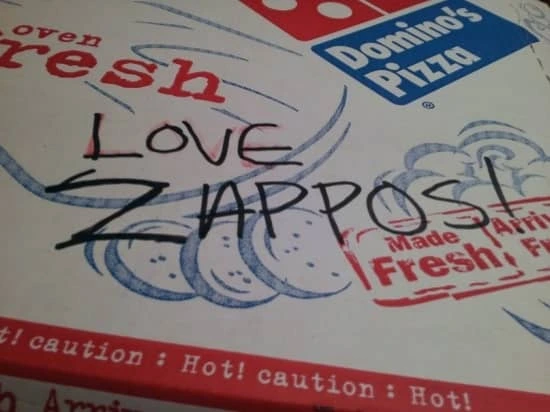
While Zappos provides an extreme example of customer care, creating an emotional connection by meeting and exceeding customer service expectations doesn’t have to be so extravagant.
Apple has built a cult following simply by demonstrating that it understands the needs of its users. Nike recognizes its customers’ dreams and ambitions, and the brand uses marketing to show how it can help with the journey.
French beauty brand L’Occitane simply provides customers with beautifully presented deliveries and free gift-wrapping—making a memorable impression which, for many of its customers, is more appreciated than a discount.
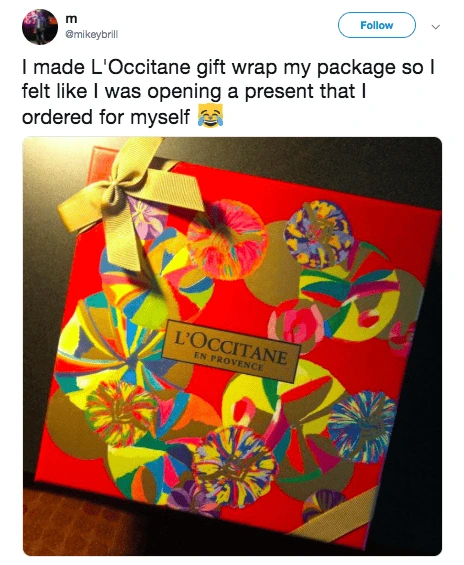
2. Be consistent
For online marketers, consistency is key. Sharing content which demonstrates a consistent tone and style builds both visibility and trust for a brand.
Without the trust of your audience, there is no way you’ll be able to build a strong emotional bond that will keep customers coming back.
Here are some practical ways to ensure brand consistency:
- Set out your brand values. Share them with the whole team to help employees at every level stay on-brand and make decisions that reflect your brand’s true personality.
- Create a set of brand guidelines. Outline your brand’s tone of voice and key design elements like font, color palettes and correct presentation of the logo.
- Put together a social media style guide. This will reinforce some of the elements set out in the brand guidelines, but it will also advise the social media team on which content they should post and how to respond to criticism.
- Use a branded URL shortener. Customize your short links so they are on-brand. This will improve brand consistency and build trust with your audience. For example, Rebrandly links receive up to 39% more click-throughs because consumers trust them.
- Create design templates. From presentations to social media images, make it simple for everyone to create high-quality, on-brand content. Then, make them accessible to the whole organization through a brand templating platform like Lucidpress.
- Monitor brand mentions. Keep an eye on what’s being said about your brand online using Google Alerts or another brand monitoring tool. Determine if your brand is coming across as intended and connecting emotionally with consumers.
3. Give customers an experience they won’t forget

Beyond providing great customer care, consider what other kind of experiences your brand can use to build an emotional connection with customers. Big brands often sponsor concerts and sporting events—or run their own. What could be your brand’s Disneyland?
If you have a brick-and-mortar location, could you host an entertaining event? If you’re working with a smaller budget, could you provide an Instagrammable installation in-store? This is a simple, but impactful, way to connect with consumers in today’s digital world.

Source: Redemption Bar
Provide a positive experience as customers use your product or service wherever possible. UX is growing in importance for online businesses and is intertwined with the overall brand experience.
Companies like Slack impress customers by providing a helpful and supportive experience through friendly reminders, convenient app integrations, and cleverly auto-populated gifs.
Alternatively, you can use marketing campaigns to align your brand with a particular lifestyle or emotional experience. Coca-Cola’s “Open Happiness” campaign is a clear example of this.
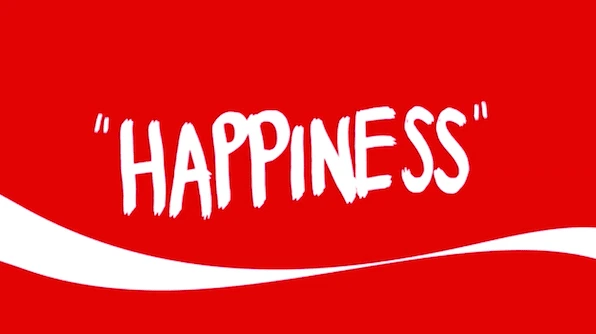
4. Put a friendly face at the center of your brand
Whether it’s a celeb, an Instagram influencer, or an employee-turned-brand-ambassador, sometimes the best way to connect with consumers on an emotional level is through a warm human personality.
Female consumers don’t go through enormous lengths to get one of Kylie Jenner’s lip kits just because of the product’s quality. They do this because of their love for the company’s CEO.
You don’t have to have a famous face to build a close relationship with your audience. Many charismatic CEOs have become the heart of their company’s brands.
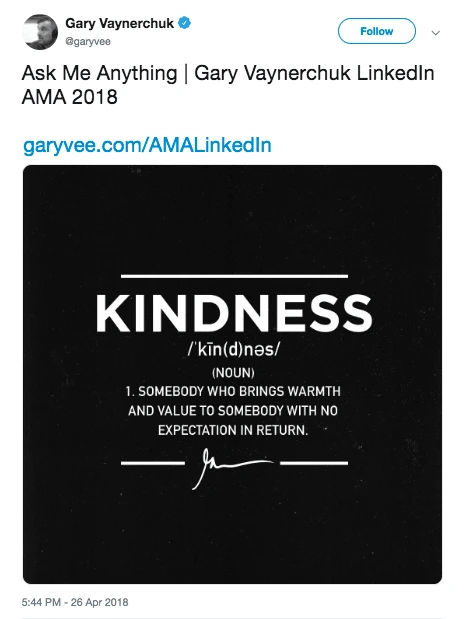
Think of Gary Vaynerchuk or Neil Patel, who have both built strong personal brands and businesses through social media. Their willingness to share knowledge and expertise with consumers has helped them to connect with audiences on an emotional level.
On a smaller scale, it’s very possible for a friendly waiter to drive customer retention by creating personal connections with diners. Brand ambassadors can come in many forms, and they’re a great way to reinforce brand values and build rapport with customers.
Key takeaway
Emotional branding builds lasting relationships with your audience and can improve the profitability and longevity of your business. You want to bring your customers to a point where they can’t imagine going to anyone else to get the products or services you provide.
Big brands are leading in this area, but small businesses can get in on emotional branding through the smallest of gestures and actions. As social media algorithms change and internet browsers seek out online communities, connecting emotionally will become a key strategy for cutting through the distractions of the modern world and reaching audiences.
Learn more about the power of emotional branding & storytelling in our webinar with branding expert David Brier.
Webinars don’t have to be a slide presentation snoozefest. In fact, they’re a great option for creating cost-effective content and harnessing the sales leads of your dreams. Hosting a webinar is fairly simple… it’s getting people to come that you’ll have to spend more time on.
We’ll tell you how to host a webinar and rustle up attendees — and we’ll give you tips for creating an engaging experience that’s good for business and fun for your guests.
Benefits of hosting webinars
As long as you’ve got a dynamic speaker and an interesting topic, there are few drawbacks to hosting a webinar.
You have access to a bigger audience
- Theoretically, you could ask people from all around the globe to attend! A webinar is a great opportunity to expand your audience — there are no travel constraints, and concerns about cost and time are almost nil. The low-commitment aspect of a webinar will draw people in like flies to honey.
It’s waaay cheaper than hosting an event IRL
- Without the cost of renting a space, putting up your guest speakers and coordinating a large event, you can instead put funds toward advertising your webinar and getting a healthy list of attendees.
You’ll generate high-quality leads
- Your attendees are basically a bundle of qualified leads. The people who come to your webinar are already at least somewhat interested in your area of expertise, and you’ll capture all their info when they register for the event. Bam! A nice, tidy list of leads to pass along to the sales team.
You can reuse the content
- Once you’ve got a solid webinar under your belt, you can repurpose it in all sorts of ways. Chop it up into choice tidbits and use the video clips in a blog, LinkedIn ads, your next email campaign… anywhere you need an extra boost of expert content.
10 tips for creating and hosting a successful webinar
Here are our top ten tips on how to host a webinar — including the little touches that will keep things on the right track.
1. Choose a platform
You’ll ideally want to pick a webinar platform that you feel comfortable navigating. There are a lot of options out there and they all offer similar features: poll and chat functions, data on attendee engagement and the ability to record. It will probably come down to price and the user interface you like best to help you decide. We like Demio, GoToWebinar and the ubiquitous Zoom.
2. Set the date
Pick a day and time that will work the best for the most people. Make sure you choose a time that’s doable for both the East and West Coast. Something like Friday at 3:00 p.m. EST would work well since that happens at noon or a little later for the rest of the country.
3. Get the word out
Drumming up a good number of attendees is where you’ll put in a lot of work. You need to effectively market your webinar and get people interested. First things first, you’ll want a landing page for the event with information about the topic and speakers, as well as your registration form.
Put together an email drip campaign to send out to prospects and start promoting the event on your social media channels. You’ll want to start marketing at least three weeks before your webinar, but a couple months in advance is ideal.
4. Polish your presentation
You’ll want to spend extra time making sure the visuals for your webinar presentation are on point. Without live, face-to-face interaction, you won’t be able to read the room and get a feel for how your audience is responding. Your best bet is putting together a presentation that you know will keep your guests focused and interested.
The easiest way to put together an eye-catching presentation is to find a perfect webinar template that’s polished and represents your brand well. We’ve got loads of customizable presentation templates that you can tailor with your brand’s logo, colors, fonts, etc.
5. Keep your audience engaged
You don’t want your presenter to just drone on endlessly. Break up the webinar with polls and interactive Q&A sessions. Most webinar platforms come with built-in tools for polls, questions and chat, so your audience can engage with the content or “raise a hand” and ask a question.
You can also create a hashtag for your event so people can discuss their insights during and after the webinar on platforms like Twitter and LinkedIn.
6. Do a dress rehearsal
With big events, you don’t want to be flying by the seat of your pants. Run through the webinar a couple days beforehand so you have enough time to fix any issues that pop up. Make sure your video platform is running smoothly, check that a test attendee can see and hear you clearly, confirm that any transitions between slides or speakers go as planned, and so on.
7. Record it
Make sure you record your webinar! This is what you’ll repurpose into future content. You can go in after the live recording and edit out any glitches or remarks that won’t be needed for a rebroadcast. You can also send out the recording to all the participants, so they can refer back to it in the future.
8. Use a mic
Get a wired headset mic for each one of your presenters. Yes, they look geeky, but it will ensure that everyone can hear clearly. Poor quality audio makes it hard to concentrate and is just plain annoying.
(And please, for the love, make sure all presenters mute their computer notifications while they’re on so listeners aren’t assailed with pings and dings throughout the event.)
9. Have someone there for tech support
The last thing you want to be doing while hosting a webinar is worrying about tech issues. Have a designated tech person on hand who’s ready to handle any problems.
10. Send out a survey after
Send a survey to participants shortly after the event and solicit their feedback. Getting input from your attendees will help you know what went well and where you can improve for your next go-round.
With the right preparation, webinars can be a breeze to plan and a boon for your business.
For help with creating a beautiful, on-brand webinar, don’t miss our free webinar templates.
In today’s digital economy, it’s easy for businesses to look dated quickly and out of sync with what’s “in.” If you’re worried that customers or clients are finding your work or services blasé, you can easily send the message that you are on top of your game with a webinar presentation.
A well-curated webinar presentation can be a game-changer by keeping your branding consistent, visible and top-of-mind. It also engages the audience by offering visuals that help them retain information for longer periods.
With the aid of our modern marketing presentation template, you can easily highlight how your business is staying on top of current trends. And, ultimately, our professionally-designed slide template saves you (or your sales team) time by not requiring you to start from scratch.
To create the perfect webinar slide or webinar template (for others to recreate down the line), follow along with the tutorial below using our modern marketing presentation template.
Best practices for creating a webinar slide
In short, you need your webinar template slides to be:
Captivating
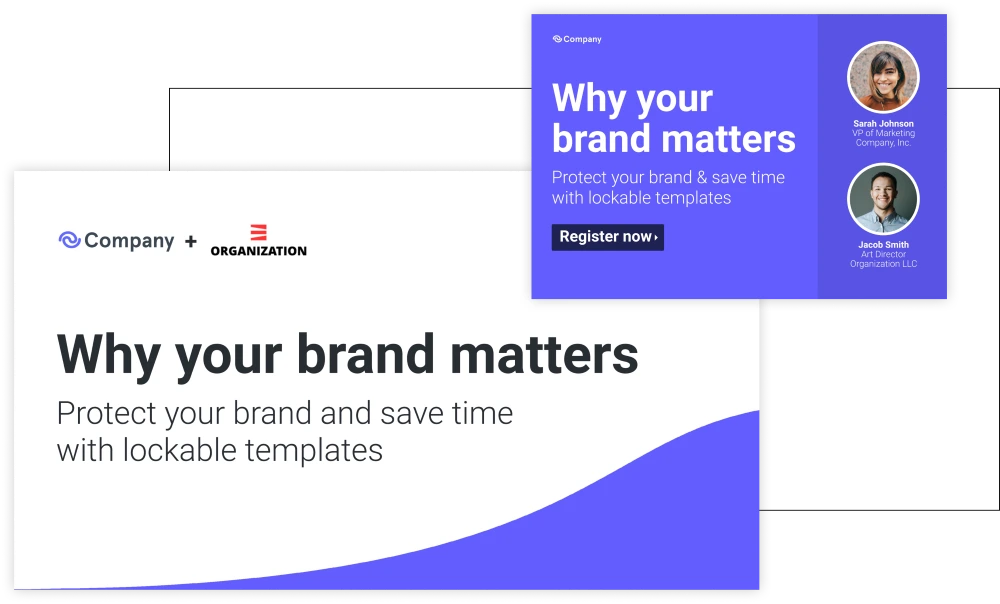
Just as you were taught in school, you need the beginning of your webinar presentation to be captivating.
Remember how your teachers drilled it into you that that first line of your book or essay was the thing that would hook people into continuing [to read your piece]? Well, that same principle will apply for your title webinar slide.
Not only will the title slide be the first thing your audience will see, but it can also potentially be used for promotions along with the splash screen (a.k.a. the thumbnail) for the on-demand version of your presentation.
To create a captivating and enticing title slide, you will need to use a few things:
- Title: Keep the title of your presentation exciting but straightforward. Use an easy-to-read sans serif font.
- Subtitle: The subtitle will be smaller in size than the webinar title and should also be written using the same sans serif font — but with styling such as italics or bold. Use this section to expand on your title so your audience will know exactly why they should click and continue.
- Logos: Never forget to include your logo in any promotional material that your business produces. On your title page, this will clearly show who is hosting the webinar. If you are co-hosting with another company, be sure to include their logo on the title slide as well.
- Image: Select an appealing and eye-catching image as the background of your title slide, or as a supplement to the design. With our modern marketing presentation template, you can see how the title sits on a white rectangle, allowing readers to read the necessary information easily while also providing an engaging and professional look.
Consistent
With any (and all) branding for your business, your webinar slides need to have a consistent color palette, along with consistent font usage and other design elements.
You don’t necessarily need to use brand colors, but the colors should remain consistent throughout the slides. Pick two to three colors that are easy to read with your text and stick with them throughout the entire presentation. You can use these colors for shapes and backgrounds, text boxes, or even as transparent image overlays.
Simple
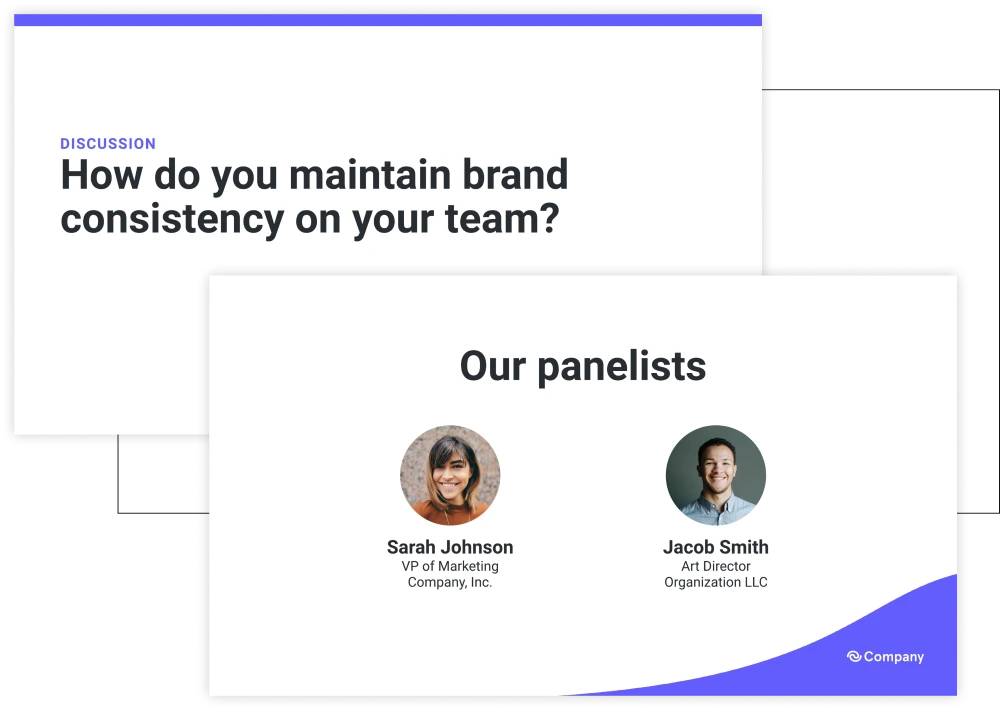
The more crowded your webinar slide deck, the more likely you are to lose your audience.
For example, when creating your webinar template slide, if you create a slide to introduce your webinar speakers, have the slide include headshots of each presenter along with their name and title. Skip the bios. Those can be included in your script, but will only clutter the slide. A good rule of thumb is that if you are going to be talking about the context of the slide in your script, then don’t include it as text, or only do so as bullet points.
Compelling
Include an agenda slide at the start of your webinar presentation. By doing so, this slide will help your audience know what to expect from your presentation.
Make this slide extra compelling — tell them right off the bat what they stand to gain by engaging with you and your webinar. The more compelling this slide, the more likely they are to continue. Remember to keep it simple by using bullet points and keeping the slide’s text concise.
Informative
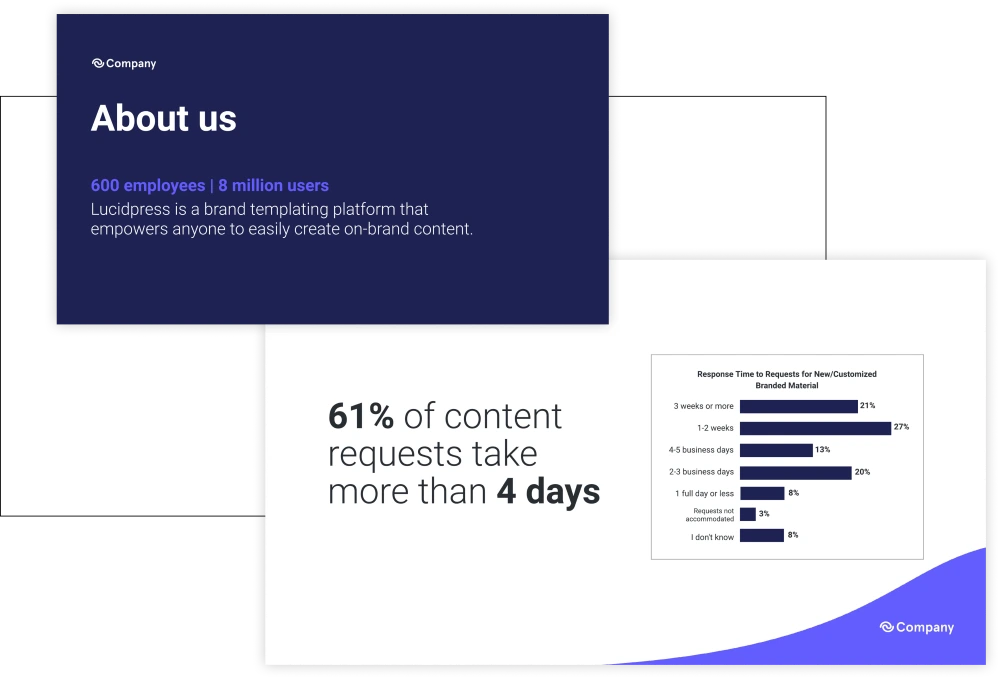
Try to include a few slides highlighting stats about your business or services. Stats can add credibility to your message while also solidifying your script. Infographics are a great way of demonstrating compelling stats.
That said, you also need your webinar to have:
Screenshots
Because we spend so much time on our phones and computers, there is a chance you will need to include screenshots during your presentation to help explain things.
Your webinar template should include slides featuring mobile screenshots and computer screenshots. Again, keep these slides simple: include the screenshot with a couple of explanatory bullet points.
Visual aids
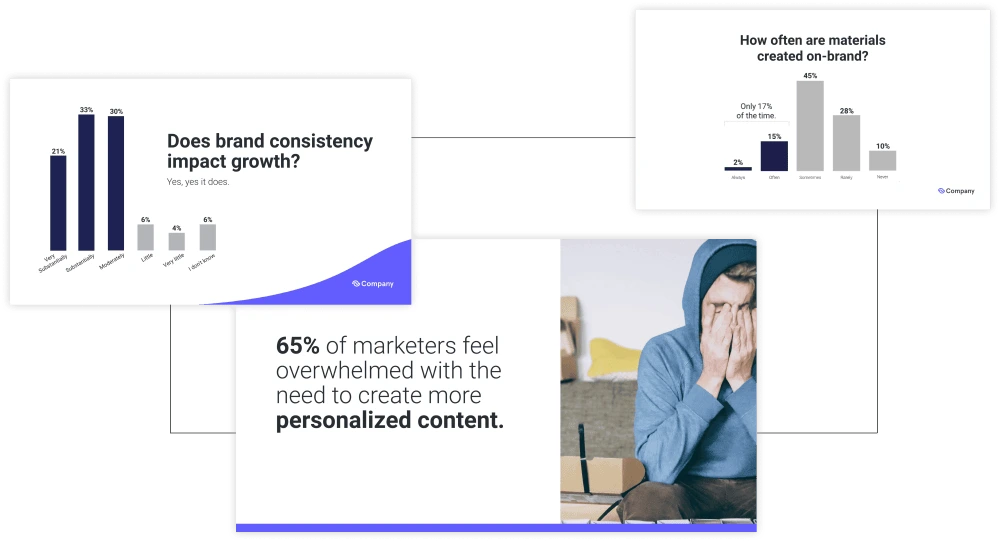
Graphs, charts and icons can take your webinar to the next level.
They will help explain key points while also aiding in getting end goals across. Photography is another way to make your presentation stand out. If you don’t have in-house photography, consider using stock photos.
A recap
A recap slide is a helpful way to wrap up and remind audience members about the key takeaways for your webinar.
Enough of us know what it is like to get to the end of a webinar and have already forgotten several key points. Use a recap slide that provides key takeaways. Repetition will help your audience remember your key message and also give them something to think about after the webinar.
A call-to-action (CTA)
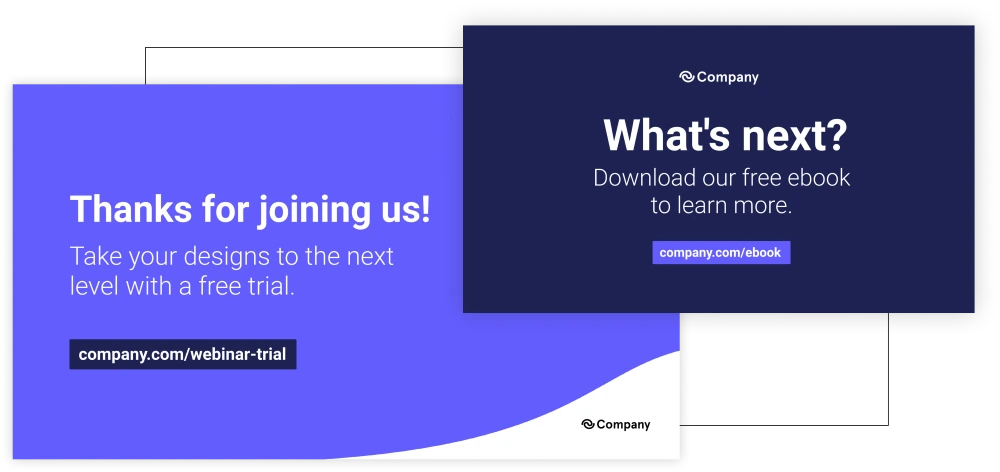
A CTA slide is must-have-necessary for your webinar presentation template.
Use this slide to engage your audience by allowing them to sign up for another webinar, try a new product, complete a purchase, etc. Make sure your CTA truly resonates with the audience and make sure it’s the last thing they see before exiting the webinar.
Let’s get started
Now that you know the elements needed to create the perfect webinar template and presentation, you can start creating your own. Or better yet, download our modern marketing presentation template here and save even more time. You can also find more marketing presentation templates right here.
If you are looking for help in hosting a webinar, check our blog post “How to host a webinar.”
You can’t really have a webinar without an audience. And in order to get an audience, you need to employ proper marketing tactics — like an effective webinar email sequence. And in order to do that quickly, efficiently and at a relatively low cost, you could probably benefit from using a webinar email template.
Sounds pretty simple, right? Right! But, first things first.
Webinars for the new normal
Simply put: webinars level the playing field.
Those who attend webinars stand to benefit from unobstructed access to field experts and information that they may not have access to otherwise. On the other hand, those who host webinars gain insight into prospective customers or qualified leads.
Though, ultimately, during times like these where our new normal largely entails remote agendas and telecommunications, webinars empower attendees and hosts to connect, learn and keep moving forward.
So, all that said, hosts need to do a little more legwork than simply hosting a webinar. In other words, you need to create an email nurture campaign like you would for any other project.
So, what can you expect to learn or read about during this article? A few things, namely:
- What to include in a webinar invitation email, along with examples of a webinar announcement template.
- What to include in the webinar post-registration email, along with an example of a webinar post-registration email template.
- What to include in the webinar follow-up email, along with an example of a webinar follow-up email template.
A few webinar email template tips and tricks
Before we get the ball rolling, let’s tackle some “need to know” pieces of information.
First, make sure your webinar slides are completed or in the very least in an approved rough draft form. Having a hard time getting the creative juices flowing? No worries, we’ve got you covered with our helpful article about how to create an effective webinar slide.
Ready to take things to the next level and write your emails? Great! Be sure to consider and include the following tidbits when crafting up your campaign:
- The What — Also known as your webinar title.
- The When — The time and date that your webinar is slated to occur. Be sure to include the time zone and whether or not the webinar will start exactly at a certain time. Just remember you might have some stragglers popping in at the last minute!
- The Who — Your attendees need to know who is speaking at this webinar, of course! And don’t forget to include a note about your host or sponsors.
- The Where and How — Here’s your opportunity to include a registration link or what have you. This also includes CTAs and other buttons or links, too.
- The Why — Make sure it’s clear to attendees why they should attend this webinar and what they stand to gain and learn.
- The Little Details — To reduce errant queries or emails, relay to attendees whether or not there are any required skills (needed to attend the event), speaker or host biographies, and whether or not there will be time for a Q&A at the end of the event.
Also, whatever you do, don’t forget to include a subject line!
Now, onto the next section.
How to create a great webinar invitation email
How often do you get to make a second-first-impression? Kind of never. So, as you craft up your webinar invitation or announcement emails, remember to:
Keep it concise
Use whatever salutation you prefer, but remember to keep it simple, sender! Ultimately, you want your webinar invitation email to be concise, inviting and approachable.
Include helpful pieces of information
So, we just told you to keep your invitation email concise, but you don’t want to be too concise because then you could leave your audience hanging. Be sure to include relevant tidbits of information about the webinar, like the ones we mentioned in the tricks and tips section above. By not including this information, you run the risk of having low registrations or not having any at all.
Provide extra context about your presenters
Now’s the time to introduce your webinar presenters and speakers. You’ll want to include bios, headshots and so forth. Doing so can help sway participants who might be on the fence about signing up.
Make it a little flashy
You don’t want to go too crazy, but you do want to give your webinar invite email a little pizazz. Components like gifs, eye-catching images or videos can add a little bit of flash without going totally off the rails. You can easily use our webinar invite template to get started. You can even put your own custom twist on the template and send it off to your marketing team to fill in the blanks — without having to stress about anyone going hog wild with fonts or images.
Leverage frequently asked questions
No matter how hard you try, you’re going to encounter opposition from prospective webinar attendees. So, do yourself a favor by addressing the skeptics with frequently asked questions. Not only does this help build rapport, but it nurtures a sense of relatability.
Use CTA buttons
Use CTAs to balance the copy and visual content. We recommend including one at the top (or middle) and at the very bottom of the email. And remember — stick to on-brand colors and fonts, otherwise you might visually confuse your reader!
Webinar invitation email template example
Get the word out with our webinar invitation template.

How to create a memorable post-registration email
Once someone registers for the webinar, the next step is to send out a post-registration email. This helps keep the chain of communication open and helps to ensure that the participant follows through and attends the webinar.
It’s worth noting that you should send a few invitation reminder emails out — such as the day before and day of the webinar. Remember you want to drive attendance, so you can, in turn, increase your chances of attaining qualified leads.
Confirm registration
Above all else, you want to make sure that you confirm their registration for the webinar. The Internet can be an unpredictable black hole and sometimes things fall through the cracks. Don’t let your participants think your webinar and their registration was one of them.
Ask a rhetorical question
You don’t want to create a false sense of insecurity or urgency, but you do want to remind the participant that they have something important to learn and gain by attending your webinar. Not only that but it also effectively sets you up to introduce your product after the webinar in your follow-up email.
Include links
For example, you can include links that allow the participant to add the event to their calendar, invite a friend or cancel just in case something comes up that prevents them from attending.
Post-registration email template example
Keep communication flowing with our post-registration email template.

How to create an excellent webinar follow-up email
Before you send out your webinar follow-up email, we suggest creating different recipient segments based on job titles or industries. This will help you custom-fit your follow-up email messaging based on your audience’s needs and ensure your email resonates with them — instead of falling flat.
Offer your appreciation
First and foremost, remember to thank your webinar attendees for taking the time out of their day to listen in. After all, everyone likes to feel appreciated!
Address their pain point
Webinars often wind up being a great source for MQLs. So without being too pushy or going overboard with a sales pitch, try gently addressing the pain point that your webinar sought to solve. From there, you can introduce your product or service and how it helps to clear up or abate the issue.
Provide a “replay” link
A replay link keeps your webinar top of mind for attendees — and should a registrant miss the webinar altogether, it ensures your presenter’s messages and information still reach your target audiences.
Webinar follow-up template example
Make your attendees feel valued and appreciated with a little help from our webinar follow-up template.
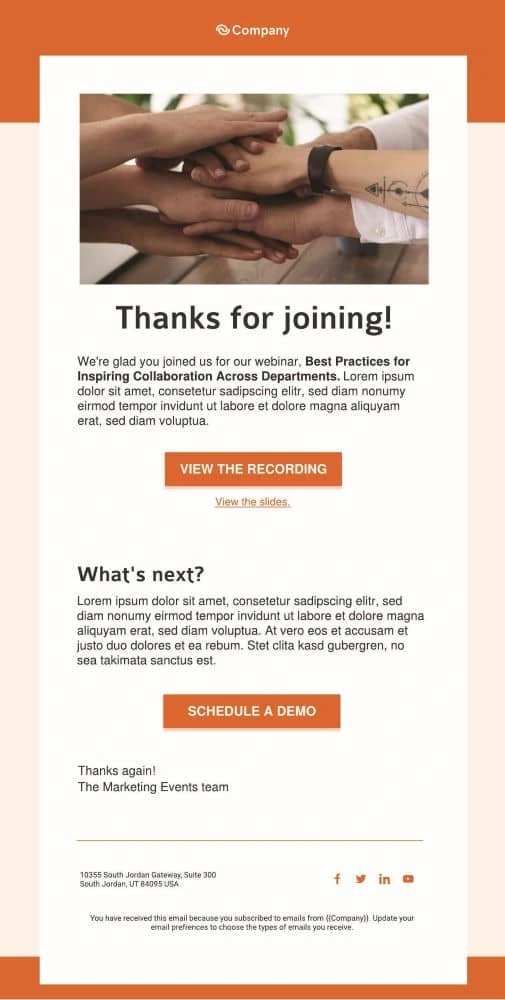
Let the good times roll
At the end of the day, webinars are extremely effective marketing and educational tools. However, keep in mind that most webinars have a 46% attendance rate, so no matter what you want to ensure that your webinar emails are on-point, on-brand and consistent. Unsure how to create a solid email sequence without succumbing to the Doomed Wall of Text? We got you — check out any of our free email newsletter templates to get started.
Also, if you have your own webinar email tips, we’d love to hear about them! So feel free to share ‘em with us.